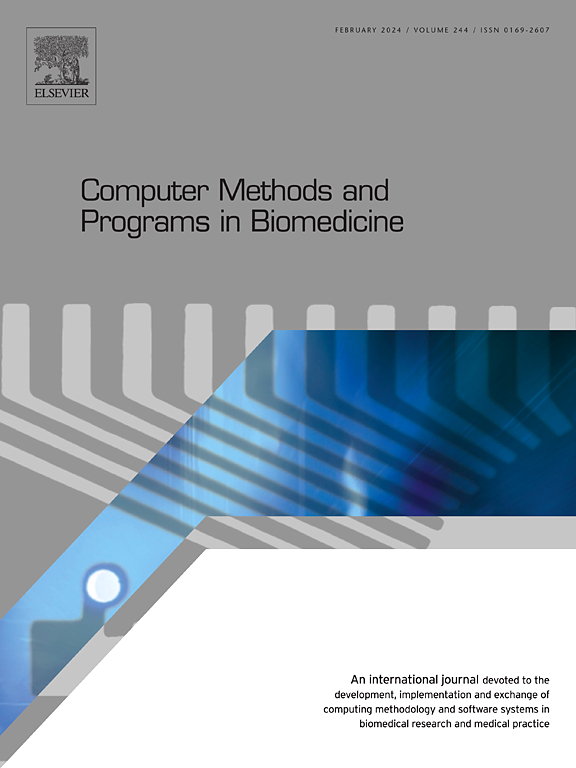Fusion of multi-scale feature extraction and adaptive multi-channel graph neural network for 12-lead ECG classification
IF 4.9
2区 医学
Q1 COMPUTER SCIENCE, INTERDISCIPLINARY APPLICATIONS
引用次数: 0
Abstract
Background and objective:
The 12-lead electrocardiography (ECG) is a widely used diagnostic method in clinical practice for cardiovascular diseases. The potential correlation between interlead signals is an important reference for clinical diagnosis but is often overlooked by most deep learning methods. Although graph neural networks can capture the associations between leads through edge topology, the complex correlations inherent in 12-lead ECG may involve edge topology, node features, or their combination.
Methods:
In this study, we propose a multi-scale adaptive graph fusion network (MSAGFN) model, which fuses multi-scale feature extraction and adaptive multi-channel graph neural network (AMGNN) for 12-lead ECG classification. The proposed MSAGFN model first extracts multi-scale features individually from 12 leads and then utilizes these features as nodes to construct feature graphs and topology graphs. To efficiently capture the most correlated information from the feature graphs and topology graphs, AMGNN iteratively performs a series of graph operations to learn the final graph-level representations for prediction. Moreover, we incorporate consistency and disparity constraints into our model to further refine the learned features.
Results:
Our model was validated on the PTB-XL dataset, achieving an area under the receiver operating characteristic curve score of 0.937, mean accuracy of 0.894, and maximum F1 score of 0.815. These results surpass the corresponding metrics of state-of-the-art methods. Additionally, we conducted ablation studies to further demonstrate the effectiveness of our model.
Conclusions:
Our study demonstrates that, in 12-lead ECG classification, by constructing topology graphs based on physiological relationships and feature graphs based on lead feature relationships, and effectively integrating them, we can fully explore and utilize the complementary characteristics of the two graph structures. By combining these structures, we construct a comprehensive data view, significantly enhancing the feature representation and classification accuracy.
融合多尺度特征提取与自适应多通道图神经网络的12导联心电分类
背景与目的:12导联心电图(ECG)是临床上广泛应用的心血管疾病诊断方法。导联信号之间的潜在相关性是临床诊断的重要参考,但通常被大多数深度学习方法所忽视。尽管图神经网络可以通过边缘拓扑捕获导联之间的关联,但12导联ECG固有的复杂相关性可能涉及边缘拓扑、节点特征或它们的组合。方法:在本研究中,我们提出了一种融合多尺度特征提取和自适应多通道图神经网络(AMGNN)的多尺度自适应图融合网络(MSAGFN)模型,用于12导联心电分类。所提出的MSAGFN模型首先从12条引线中分别提取多尺度特征,然后将这些特征作为节点构建特征图和拓扑图。为了有效地从特征图和拓扑图中捕获最相关的信息,AMGNN迭代执行一系列图操作来学习最终的图级表示用于预测。此外,我们将一致性和差异约束纳入我们的模型中,以进一步细化学习到的特征。结果:我们的模型在PTB-XL数据集上得到了验证,受试者工作特征曲线下面积得分为0.937,平均准确率为0.894,最高F1得分为0.815。这些结果超过了最先进方法的相应指标。此外,我们还进行了消融研究,以进一步证明我们模型的有效性。结论:我们的研究表明,在12导联心电分类中,通过构建基于生理关系的拓扑图和基于导联特征关系的特征图并进行有效整合,可以充分挖掘和利用两种图结构的互补特性。通过组合这些结构,我们构建了一个全面的数据视图,显著提高了特征表示和分类精度。
本文章由计算机程序翻译,如有差异,请以英文原文为准。
求助全文
约1分钟内获得全文
求助全文
来源期刊

Computer methods and programs in biomedicine
工程技术-工程:生物医学
CiteScore
12.30
自引率
6.60%
发文量
601
审稿时长
135 days
期刊介绍:
To encourage the development of formal computing methods, and their application in biomedical research and medical practice, by illustration of fundamental principles in biomedical informatics research; to stimulate basic research into application software design; to report the state of research of biomedical information processing projects; to report new computer methodologies applied in biomedical areas; the eventual distribution of demonstrable software to avoid duplication of effort; to provide a forum for discussion and improvement of existing software; to optimize contact between national organizations and regional user groups by promoting an international exchange of information on formal methods, standards and software in biomedicine.
Computer Methods and Programs in Biomedicine covers computing methodology and software systems derived from computing science for implementation in all aspects of biomedical research and medical practice. It is designed to serve: biochemists; biologists; geneticists; immunologists; neuroscientists; pharmacologists; toxicologists; clinicians; epidemiologists; psychiatrists; psychologists; cardiologists; chemists; (radio)physicists; computer scientists; programmers and systems analysts; biomedical, clinical, electrical and other engineers; teachers of medical informatics and users of educational software.
 求助内容:
求助内容: 应助结果提醒方式:
应助结果提醒方式:


